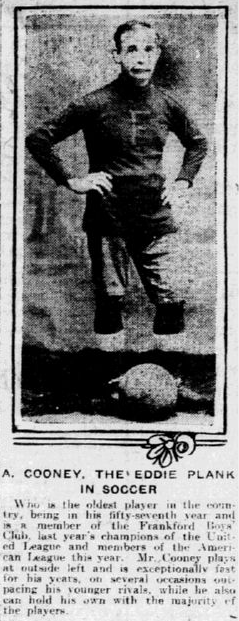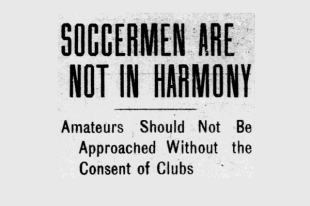Bethlehem ordered to replay American Cup tie
On Oct. 11, 1913, Bethlehem had handily defeated Wissinoming of the professional Pennsylvania League 5-1 on the road in the first round of the American Cup tournament, the Inquirer reporting on Oct. 12 that the home team had been “out-played from the beginning” by the fast combination play of “the up-staters.” On Oct. 19, the Inquirer reported that the American Football Association, the organizers of the tournament, had ordered that the game would have to be replayed because Bethlehem had fielded an ineligible player, Bobby Morrison.
Morrison had last played for the Pennsylvania League club Tacony FC. But when Bethlehem signed Morrison, Tacony had not given their consent to Bethlehem for Morrison to play in the American Cup tournament, which Tacony was also participating in. Tacony had won the tournament in 1910 and appearing in the epic three-game 1912-13 final that was eventually won by Paterson True Blues.
The Inquirer reported that not only had the AFA ordered the match against Wissinoming to be replayed, but that Morrison was banned from playing in any other American Cup games for the remainder of the tournament. Morrison could represent Bethlehem in other games and he did so in an exhibition game on Oct. 18 against Standards FC of Phillipsburg, NJ. He even scored one of the goals in the comprehensive 7-0 victory.
The poaching problem
The issue of players being lured away from one club by another was a common one in an era in which questions of jurisdiction were as numerous as the organizing bodies that claimed it. The United States of America Football Association, now known as the US Soccer Federation, had only been founded a few months earlier in April and its authority seems to have been questioned as much as it was welcomed.
On Oct. 21, The Inquirer noted that an Allied League club had signed several players from the American League “without even asking the club they were members of for that privilege, and in consequence it has created a lot of discussion on the supposed harmony that exists at the present time among soccer men in this city and vicinity.”
Both the Allied League and the American league were members of the Football Association of Eastern Pennsylvania and District, the USFA’s regional organizing authority. As such, clubs were required to have their players sign “Form C” if clubs wished to protect them from unwanted advances from other clubs. To the Inquirer, the problem was simple: “The United States Association ignores league forms which have been in vogue practically ever since soccer was first played here. To the average layman there does not appear to be much fostering and developing of the game when clubs in the various leagues can take one another’s players without even gaining the consent of the clubs they have first signed for unless they have attached their signatures to Form C.”
The article’s unidentified author writes that he had “always been under the impression that where there was a sort of interleague recognition that none of the players would be approached unless the respective leagues had first been notified.” But moving from the authority of what had been custom to an authority based upon verifiable rules and regulations was as much a part of the USFA’s mission to foster and develop the game as anything else it might do, such as organize the National Challenge Cup tournament, known today as the US Open Cup. While it was undoubtedly disharmonious for member leagues of the Eastern Pa. and District to be poaching players from one another, if the leagues did not adhere to the rules laid out by the USFA, there was little the national organization could do.
Some of Philadelphia’s leagues appeared to be getting the message. On Oct. 20, the Inquirer reported that the United League would distribute Form C to its member clubs at their semi-monthly meeting “to sign their players so that they can prevent them from playing in other leagues.”
League play
With the seasons of the city’s five senior leagues and two junior leagues now all underway, Philadelphia area soccer fans had a full slate of games to enjoy on Oct. 18, 1913.
In the professional Pennsylvania League, Hibernians continued their strong opening form with a 2-0 win over Tacony at Hibernia Park at Second and Allegheny and were now victorious in the first three games of the season. Future National Soccer Hall of Famer Tommy Swords scored the opening goal five minutes into the game. Victors, who had started the season with a 5-2 win over Tacony on opening day before falling to Hibs 2-0 in their second game, bounced back with a strong 6-2 win over Wissinoming at their home grounds at Torresdale Avenue and Vankirk Street.
In the American League, Philadelphia Electrics, undefeated in their first two games, made it three wins in a row with a 12-0 thumping of Whitehall Rovers, whose goal differential now stood at -17. Boys’ Club administered a thumping of their own, defeating Frankford Boys’ Club 7-0. Victoria Plush Mills had started the season with a 9-2 loss to Frankford on opening day and followed that up with a 7-0 loss to Boys’ Club. Playing their third game of the season at their new inclosed grounds at Clifton Heights, Victoria administered a drubbing of their own, defeating Burns’ Rangers 8-2.
Victor Athletics preceded their American League match against Cardington with a parade around their new grounds at Frankford and Berks streets. Although down by two goals at one point, Victor battled back for a 3-3 draw in what the Inquirer rather exuberantly described on Oct. 19 as “one of the fastest games ever witnessed in this part of the country.”
The Inquirer added, “The playing of both teams was of the sensational order all during the ninety minutes, the majority of the spectators, who had never before seen a soccer game taking a great deal of interest in the movements of the players and their efforts were applauded every time they did some fancy footwork, while the spectators marveled at the manner that the players so easily headed the ball with clock-like accuracy.”
In Allied League first division play, West Philadelphia continued their strong form with an easy 8-0 win over Wilmington’s Irish Americans. After losing 4-1 to West Philadelphia in their opener, Falls bounced back to defeat Smith AA by the same scoreline. Disston made it two wins in-a-row with a 3-0 victory over Peabody. Reading had lost to Peabody, 2-1, at Washington Park in their opening game and returned with a 3-0 home win over Kensington. The Inquirer wrote on Oct. 20, “It would not be a bad idea for the Reading team to change its name to Philadelphia Reading, for the majority of the players in the “Pretzels” lineup at the present time are from this city.”
In second division play, lopsided results were the story of the day, with the winners besting the losers by the combined total of 14 goals to three. Putnam remained the only undefeated team with two wins and a tie after drawing 1-1 with Wanderers.
Three third division games took place with Darby edging out Centenary 2-1 and Puritan defeating Edgemoor, 1-0. But the big story was St, Nathaniel. After falling 5-2 to Disston Reserves on opening day, St. Nathaniel responded with a 11-0 win over Falls YMA. That Falls played the game with only eight men was surely a factor.
Big scorelines were also the story in the seven United League games played on Oct. 18, the winners outscoring the losers 29-6. Boys’ Club, Bristol, and Vincome each scored five goals in their wins while PHL scalped league newcomers Era AA for seven goals without conceding.
In the Cricket Club League, Merchantville, who had played as Belmont since 1901 before moving to New Jersey after their West Philadelphia grounds were bought by the city for what is now known as the Kingsessing Recreational Center and holders of the Mannheim Prize for four seasons running, topped the Merion Cricket Club 4-2 in a game the Inquirer described as “full of good soccer and plenty of thrills.”



That is an amazing headline.
All these leagues results are from one day? Is this on microfilm? Someday you need to give us an article on how you research. It’s definitely entertaining stuff. Did they play without offsides. I feel like a three year old right now.
Yep, all the league games took place on Saturdays because Pennsylvania’s Blue Laws prohibited playing organized sports on Sundays. The law was finally overturned in 1931thanks to a challenge from the Philadelphia Athletics baseball team. The new law allowed only baseball to be played on Sundays. It wasn’t until 1933 when a legal challenge that was connected with the Eagles NFL franchise coming to Philadelphia was successful that other sports could also be played on Sundays.
–
The offside rule was in place but, until 1925, the rule was three opposition players had to be between the attacker and the goal. After 1925, the rule was two players until the current version of the rule was adopted in 1990.
–
So far as how I do the research, that would be telling, now, wouldn’t it;)